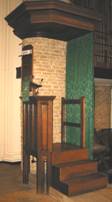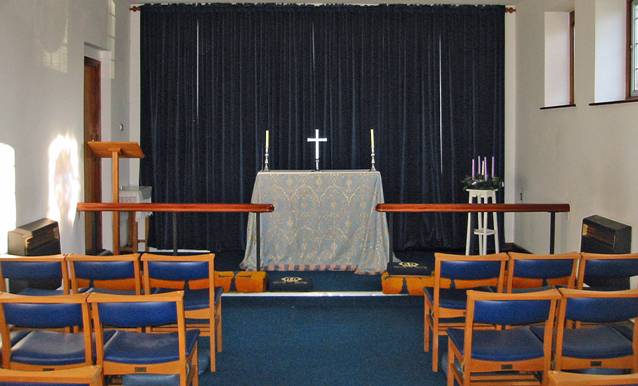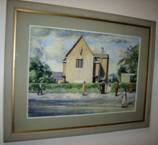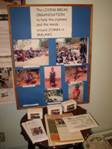HISTORY OF ST. CHAD’S PARISH CHURCH.
INTRODUCTION
In the 1920's the land at present occupied by Hollyfield Drive and the church site belonged to Miss Winifred Ansell, a member of the well-known Birmingham brewing family. Miss Ansell married a Doctor Fluett, and they set up home in a Georgian style house, surrounded by woodland, which fronted on to the present Hollyfield Road. Mrs. Fluett generously gave a large plot of her land to be used for the building of St. Chad's, and retained a wicket gate to give her direct access from her own home.
A local resident can still remember how the governess could often be seen driving the three children of the family in an open horse-drawn gig. The young son is later remembered for the way he drove his Lagonda car along Hollyfield Road. Tragically he died later in an aircrash.
The house was put up for sale before the second world-war, and was subsequently knocked down, to make way for the building of the present houses. The grounds were noted for the richness and variety of trees and shrubs which they contained, including date and fig trees. At that time the parish of Holy Trinity included the present parishes of Bannersgate, Maney and St. Chad's. When the population of Sutton began to increase a need was seen for the building of daughter churches. St. Chad's congregation began life in Sylvester's Barn in Lindridge Road, moving to the Tin Tabernacle in Whitehouse Common Road - now a Judo club - before coming to the present site in Hollyfield Road. Full independent parish status was not attained until 1959.
THE EXTERIOR
The Church was built by Messrs. Bateman and Co. being completed in 1927. The Foundation Stone was laid by Winifred Ansell in September 1925. It can be seen on the East front of the building, surmounted by an inlaid stone cross. Above this is a fine example of a stained glass window, more of which later.
 At the apex of the front gable is a
full sized figure of Christ, standing upright with arms outstretched. The
outside of the building is faced with Hornton Stone from the quarries near
Banbury. These quarries were re-opened when further supplies of stone were
needed for the building of the Lady Chapel to celebrate fifty years of life at
St. Chad's.
At the apex of the front gable is a
full sized figure of Christ, standing upright with arms outstretched. The
outside of the building is faced with Hornton Stone from the quarries near
Banbury. These quarries were re-opened when further supplies of stone were
needed for the building of the Lady Chapel to celebrate fifty years of life at
St. Chad's.
Beneath the vestry is the Crypt, with access only from outside the Church. The crypt was originally the boiler house, where the coke-fired boiler for heating the church was housed until 1956. In 1956 the present electric heating system was installed. The crypt now houses a formidable array of electrical switchgear, and is indispensable for storage of certain bulky items.
THE INTERIOR
On entering the Church by the main
door, and immediately to the left on the wall is a framed  poem by G. Herbert dated 1633.
poem by G. Herbert dated 1633.
“When once thy foot enters the church, be bare,
God is more there than thou: for thou art there,
Onely by His permission. Then beware,
And make thyself all reverence and fear,
Quit thy state,
All equall are within the churches gate.”
Thereafter, one is immediately impressed by the unusual interior. The lovely arched roof, which has a plaster barrel ceiling enriched with plaster bands, is supported by steel columns, which are faced with Hornton stone, to give an appearance of age.
 A
few steps and one is in that part of the church
A
few steps and one is in that part of the church  known as the Baptistry. This houses the carved stone font,
decorated with a pattern of pomegranates and Tudor roses, the Tudor rose being
a symbol especially associated with the Royal Borough of Sutton Coldfield.
known as the Baptistry. This houses the carved stone font,
decorated with a pattern of pomegranates and Tudor roses, the Tudor rose being
a symbol especially associated with the Royal Borough of Sutton Coldfield.
The ornamental green and gold lattice cover was suspended by a steel cable, which passed over a pulley, and was counterbalanced by a heavy iron weight, suitably decorated.
This enabled the cover to be easily raised when the font was needed for baptisms. However, it was deemed unsafe by a structural engineer and taken down.
The Baptistry also contains the arch-shaped Memorial to the men of the Parish who served in the 1914-18 War, some of whom gave their lives.
 From the back of the Church looking
East towards the altar, there is seating accommodation for some 200 persons.
From the back of the Church looking
East towards the altar, there is seating accommodation for some 200 persons.
In the wall on the left some five feet from the ground, can be seen a hole in the brickwork serving no apparent purpose. The story goes that during the building of this wall, a pair of robins decided to nest there, and rather than disturb them, the workmen carried on around them and the hole was never filled in.
Either side of the war memorial there are two further memorials listing the past vicars on the left and past church wardens on the right.
Proceeding down the aisle one passes
the churchwardens’ staffs, which were presented to St. Chad's by Holy Trinity in May 1959 on our reaching parochial status. The staffs are carried by the
Wardens of the church in Processionals, 
 being symbolic of the time when the Bishop and Clergy
needed to be protected from villains. The original ornamental tops have been
replaced following their loss in 1976 when the church was vandalised. One was
in the form of a crown - for the people's warden and the other a Bishop's
Mitre, for the vicar's warden.
being symbolic of the time when the Bishop and Clergy
needed to be protected from villains. The original ornamental tops have been
replaced following their loss in 1976 when the church was vandalised. One was
in the form of a crown - for the people's warden and the other a Bishop's
Mitre, for the vicar's warden.
On approaching the Chancel from the centre aisle, one may observe on the left the grand pulpit, with a canopy above, while on the right is the splendid carved wood lectern, with the Holy Bible in position for readings during Services. Immediately above the pulpit there is in the ceiling, a plaster figure (head and shoulders) of a lady in the attitude of prayer, who it is said to be St. Cecilia, the patron saint of Music. Also in the plaster work can be seen a number of other well defined mouldings.
In the Chancel are the choir stalls with space for around forty choristers. On the right is the organ console. Above the choir stalls on the left is the organ loft, containing the organ pipes and the electric wind pump which supplies them with air. The junior and Lady Choristers also use this loft as a Vestry. The original organ was replaced in 1959 by the present one. The tubular metal pipes which form the ornamental front of the organ loft are from the original organ, and are no longer in use. The organ engineers say they are unfriendly and mute as they no longer speak.
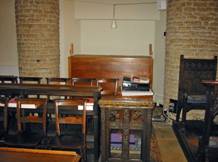 The first organ, used at the opening
service in March 1927 was a small, second-hand single manual. The second one
was purchased from Canwell Parish Church, was slightly larger, single manual
with pedals, built by the London Positive Organ Company. The console of this
organ was, however, located in a most unfortunate part of the organ loft where
the organist could neither see the clergy and choir, nor hear the congregation!
The present organ is a complete rebuild by Hawkins & Son of Walsall Wood,
of the Walker instrument formerly in the now demolished Bradley Parish Church. It has two manuals of 61 note compass and a 30 note pedal board. This organ was
opened on March 27th 1960. In front of organ console on the right of the choir
stalls is a prayer desk in memory of Ellen Wing (wife of William Wing) who died
on 27 March 1917.
The first organ, used at the opening
service in March 1927 was a small, second-hand single manual. The second one
was purchased from Canwell Parish Church, was slightly larger, single manual
with pedals, built by the London Positive Organ Company. The console of this
organ was, however, located in a most unfortunate part of the organ loft where
the organist could neither see the clergy and choir, nor hear the congregation!
The present organ is a complete rebuild by Hawkins & Son of Walsall Wood,
of the Walker instrument formerly in the now demolished Bradley Parish Church. It has two manuals of 61 note compass and a 30 note pedal board. This organ was
opened on March 27th 1960. In front of organ console on the right of the choir
stalls is a prayer desk in memory of Ellen Wing (wife of William Wing) who died
on 27 March 1917.
 Underneath the organ loft is the Vestry
or church office, the door of which is behind the choir stalls. Three sets of
Registers are kept in the Vestry. The Register of Weddings, in which is
recorded every wedding that has taken place since the church was opened. Copies
of these entries have to be sent regularly every quarter to the Registration
Authorities in Birmingham. As the Church of England is the Established Church,
her parish priests also have the authority of legal Registrars, hence they can
call Banns and conduct weddings without reference to civil authority.
Underneath the organ loft is the Vestry
or church office, the door of which is behind the choir stalls. Three sets of
Registers are kept in the Vestry. The Register of Weddings, in which is
recorded every wedding that has taken place since the church was opened. Copies
of these entries have to be sent regularly every quarter to the Registration
Authorities in Birmingham. As the Church of England is the Established Church,
her parish priests also have the authority of legal Registrars, hence they can
call Banns and conduct weddings without reference to civil authority.
A Baptism Register and Service Register
are the other two sets. In the latter is recorded the number of people
attending every service, the type of service, and the offertory. This
information is then signed by the clergyman who was responsible for the service.
In this way a very detailed record is kept of all services within the  church building. On the right here is
a prayer featured on the wall of the Vestry.
church building. On the right here is
a prayer featured on the wall of the Vestry.
Within easy reach of the Vestry door, at the East end of the North choir stalls is situated the processional cross. This was presented by the Shearman family in 1958 in memory of their parents.
The Lay Reader's Prayer Desk, just behind the pulpit, is also a memorial. It was presented by Mary Riding - presently a chorister at Holy Trinity in memory of her parents Harry and Blanche Riding who died in 1941, both aged 68. Similarly the Lay Reader's and Verger's identical chairs are in memory of Cyril G. R. Barron.
The Sanctuary is divided from the Choir
by a rail with a carved frontpiece, underneath which is a space for the
kneelers used during communion services. On the front of the Altar are 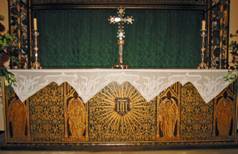 depicted from left to right, the four
depicted from left to right, the four  Archangels, Saints Michael, Gabriel, Raphael and Uriel. On
the Altar itself stands a large silver cross of unusual design, flanked by two
candlesticks. The Altar furnishings have recently been re-silvered, using six
ounces of silver.
Archangels, Saints Michael, Gabriel, Raphael and Uriel. On
the Altar itself stands a large silver cross of unusual design, flanked by two
candlesticks. The Altar furnishings have recently been re-silvered, using six
ounces of silver.
High above the Altar is a magnificently
carved and decorated Canopy, while on either side is a carved wooden reredos,
again 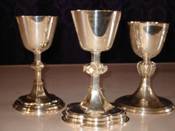 with the Sutton Tudor Rose motif.
Together, these form a frame for the beautiful stained glass window, which is
with the Sutton Tudor Rose motif.
Together, these form a frame for the beautiful stained glass window, which is  dedicated to the Ansell family,
generous patrons and members of the church. Hence this window is known as the
Ansell Window.
dedicated to the Ansell family,
generous patrons and members of the church. Hence this window is known as the
Ansell Window.
Between the Window and the Altar is a beautiful mosaic tryptich, (three pictures) depicting scenes from the life of Jesus. On the left His birth, in the centre, His crucifixion, and on the right, His Presentation in the Temple.
To the left of the Altar is a mural portraying the figure of St. Chad in his Bishop's robes. In his day St. Chad was Bishop of Lichfield, his See included the area of Sutton Coldfield with the Parish of Holy Trinity. This is one of the reasons why so many churches in this area are named after St. Chad. At the top of the picture of St. Chad are painted a chalice and bible, symbolic of a Bishop.


 Beneath
this mural are, placed for safe-keeping the standards of some of the various
organisations attached to the Church.
Beneath
this mural are, placed for safe-keeping the standards of some of the various
organisations attached to the Church.
On the right of the Altar is a second Mural, depicting St. Winifred, a further connection with Miss Winifred Ansell. The mural shows St. Winifred surmounted by the winding apparatus of a well. This is symbolic of the well into which, according to tradition, her body was thrown, she having rejected the advances of Caradoc, a local chieftain's son.
Caradoc beheaded Winifred with his sword. The actual date is not known, but is believed to be sometime in the seventh century, and the well is at Holywell near St. Asaph in North Wales.
In the pillar on the right of the Altar
is a small niche called a piscina. In earlier times this would have been used
to wash the Chalice and other sacred vessels. Also on  this pillar can be seen the mark made
by the Bishop at the Consecration of the building, together with the date.
this pillar can be seen the mark made
by the Bishop at the Consecration of the building, together with the date.
THE LADY CHAPEL
Leaving the High Altar and Chancel, a turn to the South leads through a door into the Lady Chapel. This was built in 1977, at a cost of £12,000, to commemorate St. Chad's Golden (50 years) Jubilee. Previous to this the Church wall at this point consisted of a brick, unfaced, infilling. Originally, it had been intended to build on a larger vestry when finances permitted. It took fifty years before this challenge was taken up. A similar infilling can be seen outside at the rear of the church, by the Scout Hut. The original plan here was to build on a bell tower! It is unlikely that finance will ever be found for this ambitious project. A tower built in such a position, high above Rectory Park, would certainly prove a local landmark. There was much sense and foresight shown by the planners of the original church building.

 The one bell the building possesses was
given by Mrs. Ansell, Winifred's mother, and is now unusable.
The one bell the building possesses was
given by Mrs. Ansell, Winifred's mother, and is now unusable.
The Altar in the Lady Chapel came from
the Tin Tabernacle in Whitehouse Common Road. Until the adjoining church hall was
built this Altar stood at the West end of the South wall, with the arched War
Memorial fitted above. This Altar was then known as the Memorial Altar. The
altar frontal in the Chapel was made by a group of ladies from St. Chad's, led by Mrs. Mabel 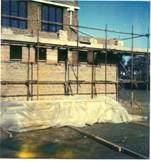
 Dorn: the altar rail kneelers by our
Lay Reader and members of the Mothers' Union. The altar rails themselves were
also given and made by a member of the congregation. The interior decoration,
and fittings were also the result of self-help.
Dorn: the altar rail kneelers by our
Lay Reader and members of the Mothers' Union. The altar rails themselves were
also given and made by a member of the congregation. The interior decoration,
and fittings were also the result of self-help.
The four photos of the construction of the Lady Chapel taken in 1975/76 were provided by Mr. Bill Jennings who was Church Warden at that time.
The chapel furniture was all provided by members of the congregation in memory of friends and relatives. The chapel is thus a very special place for many members of our present congregation.
Recently a stained glass window depicting Mary, Jesus and a shepherd, has been fitted in the South wall, nearest to the Altar. This commemorates jointly Miss Annie Williams-Weston, a life-time chorister and original member of the congregation in Sylvester's Barn: and the parents of Mr. Ken Rainsford (Ernest Leslie Rainsford 1899-1981 and Winifred Lilian Rainsford 1902-1979), our Group Scout Leader. Annie lived to see the Lady Chapel completed.
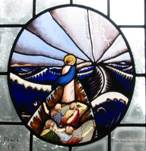 Here
on the left is the second stained glass window called “Peace be Still” and
depicting Christ calming the waves in a storm, is in rememberance of Peter Alan
Witney Watts, Canon 1937-1999.
Here
on the left is the second stained glass window called “Peace be Still” and
depicting Christ calming the waves in a storm, is in rememberance of Peter Alan
Witney Watts, Canon 1937-1999.
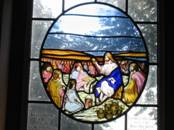 The
third stained glass window, (depicting Jesus feeding the 5000), along the south
wall of the Lady Chapel, immediately to the right here has an inscription
saying “To the glory of God in rememberance of Edward Hughes 1903-1981 and his
wife Frances Hughes 1904-1992.
The
third stained glass window, (depicting Jesus feeding the 5000), along the south
wall of the Lady Chapel, immediately to the right here has an inscription
saying “To the glory of God in rememberance of Edward Hughes 1903-1981 and his
wife Frances Hughes 1904-1992.
On the wall in the ante-room just outside the Lady Chapel is a painting of St. Chad’s Church.
In addition to the Church and Chapel,
St. Chad's also has a fine hall adjoining, with stage, kitchen, cloakrooms etc.
This is fully used by church societies and other local organisations, including
Sunday School. On the wall just to the right of the door leading from the 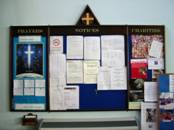 church into the corridor to the church
hall is the church mission statement; pictured here above left.
church into the corridor to the church
hall is the church mission statement; pictured here above left.
Here on the right is the Prayer Noticeboard. On the left of it, can be seen a little message board and box of papers. Prayers can be written on these and posted on the board above.
 To the left here is the Brass Offertory Plate which can
found in the Baptistry. It is inscribe “To the glory of God from Sutton
Coldfield Girls Friendly Society, March 1927”
To the left here is the Brass Offertory Plate which can
found in the Baptistry. It is inscribe “To the glory of God from Sutton
Coldfield Girls Friendly Society, March 1927”
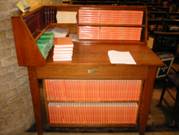 To the right here, also in the region
of the Baptistry is the book table provided in memory of William Carter, Verger
from 1933 – 1944. The book stand on the book table is dedicated to Edith L. Appleby,
1961 by her children.
To the right here, also in the region
of the Baptistry is the book table provided in memory of William Carter, Verger
from 1933 – 1944. The book stand on the book table is dedicated to Edith L. Appleby,
1961 by her children.
 To the left here, near the Baptistry is
the book rack inscribed “Presented by St. Chad’s Young Wives Group in memory of
Tessa Wright and Daisy Biddle in May 18th 1958”.
To the left here, near the Baptistry is
the book rack inscribed “Presented by St. Chad’s Young Wives Group in memory of
Tessa Wright and Daisy Biddle in May 18th 1958”.
The picture immediately to the right here is of the Malawi noticeboard, featuring photos of the Malawi Orphans, the current charity being supported by St. Chad’s.
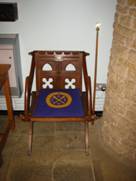 Here on the left is a picture of the Verger’
chair and Verger’s staff, which in church are situated to the right of the War
Memorial in the Baptistry area. The Verger’s chair is identical to the Lay
Reader’s behind the pulpit and both are in memory of Cyril G. R.
Here on the left is a picture of the Verger’
chair and Verger’s staff, which in church are situated to the right of the War
Memorial in the Baptistry area. The Verger’s chair is identical to the Lay
Reader’s behind the pulpit and both are in memory of Cyril G. R. 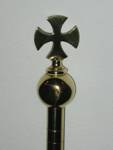 Barron.
Barron.
Below the picture of the Malawi noticeboard is a photo of the head of the Verger’s staff (kept on the right of the Verger’s chair ).
On leaving the church, notice the free
will offerings box on the left of the main door with the words of G. Herbert poem
on  the right. They are just as true now, in the 21st
century.
the right. They are just as true now, in the 21st
century.
The text for this account of St. Chad’s Church was taken from a booklet entitled “A Commentary” available on the book rack and was compiled in May 1984 by:
P. A. Harlond, Esq., Verger
W. G. Reynolds, Esq., Deputy Warden
Mrs. W. G. Reynolds
D. Dorn, Esq., Churchwarden
Mrs. P. A. W. Watts.
Date: 19-12-08.











